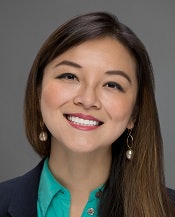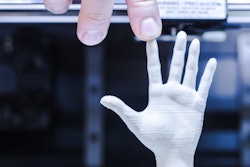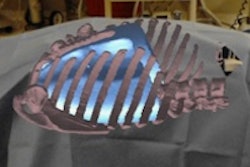
3D printing is revolutionizing medicine -- and radiology with it. But what's the best way to learn about this emerging discipline? The 3DHeals International Conference, being held in San Francisco on April 20, will explore 3D printing in healthcare with an eye on virtual reality, augmented reality, and artificial intelligence.
The meeting at the University of California, San Francisco (UCSF) Mission Bay campus will feature hands-on workshops on 3D printing and talks on everything from 3D-printed organs to prosthetics to building surgical and educational models, according to organizers.
 Neuroradiologist Dr. Jenny Chen.
Neuroradiologist Dr. Jenny Chen.Featuring experts from across the U.S., the meeting is aimed at anyone interested in 3D printing, but it will be especially relevant for radiologists, radiologic technologists, and surgeons who deal with the problems 3D printing addresses every day, according to 3DHeals founder and CEO Dr. Jenny Chen, a neuroradiologist and adjunct clinical instructor of radiology at Stanford University.
Radiology as prime beneficiary
3D printing is a natural adaptation for radiologists, according to Chen.
"On a daily basis, radiologists scan patients from the physical world into the digital world, review the digital data, and then give some kind of cognitive information to take care of them in the physical world," she told AuntMinnie.com. "Now with 3D printing we can finally convert the physical data into a 3D object that surgeons can hold in their hand."
For applications such as pediatric congenital heart disease, surgeons can plan their interventions holding the heart in their hand -- something with enormous implications for patient care that wasn't possible before 3D printing, she said.
"All of that cognitive information is now embedded in that physical object ... and there is increasing evidence that having that data available for planning is reducing operating time," improving outcomes, saving money, and wielding enormous effects on patients' lives, she said.
3D printing a surgical guide is another application with enormous potential for radiology to cut costs and improve outcomes, Chen said. Exactly what and how the new technologies will reshape healthcare is the subject of many clinical trials, both currently underway and to come.
Experience in a hurry
One key dynamic in medicine today is that older, more experienced surgeons benefit from a wealth of insight and experience they can use to, for example, "freehand the perfect incision and do the perfect surgical procedure," Chen said. But with 3D-printed surgical guides, younger doctors with less experience who are still perfecting their art or have lower baseline skill levels can now perform better, helping to satisfy market demand.
"We're an aging population," she said. Without 3D printing, "we can't meet the demand."
And of course, it's not just radiology that benefits from 3D printing. Specialties from orthopedics to cardiology are using computers and medical imaging to advance their fields.
"One of the benefits of this conference is that we combined all of the specialties in healthcare together to have a cross-pollination effect," she said.
For example, radiology has lessons to learn from dentistry, which has a wealth of experience in 3D models and will have its own track at the conference.
In all, there will be 50 speakers at 3DHeals, including the following:
- Dr. Sanjay Prabhu, co-director of the SimPeds 3D printing service at Boston Children's Hospital, will lead a medical hands-on workshop. Prabhu has a wealth of experience in 3D simulation, and his facility has a wide range of 3D printers for metal, plastic, and robotic and laboratory applications, Chen said.
- Justin Ryan, PhD, from Phoenix Children's Hospital is part of a nationwide study of congenital pediatric heart disease.
- Dr. Lisa Lattanza, professor and chief of the division of hand, elbow, and upper extremity surgery at UCSF, is one of three prominent orthopedic surgeons speaking at the meeting. Using 3D printing, Lattanza performed successful elbow surgery on a patient who lacked usable arms on both sides and now has the use of one arm thanks to the life-transforming surgery, Chen said.
- Keith Murphy, chairman and CEO of Organovo, is among the pioneers of bioprinting 3D organs and one of several bioprinting leaders attending the event. "Research is ongoing" in bioprinting and "the regulatory burden is extremely high," Chen said. "But all the science fiction will be coming true. We are innovating at an exponential rate."
The multidisciplinary nature of the conference is aimed at eliminating the silos to which technology researchers are often confined, according to Chen. The best innovation doesn't confine itself to a specific field, but rather approaches research from a problem-solving focus, endeavoring across disciplines to solve one critical small problem at a time.
"There's no way the tech people can solve it without practicing medicine themselves, and on the other hand, clinicians aren't well-educated on what's happening in the tech world," she said.
Innovating across specialties and combining clinical issues with technologies such as virtual reality, augmented reality, and artificial intelligence (AI) is what drives progress, Chen said. AI in particular will be key to making 3D printing and stereolithography (STL) files easier to produce.
For radiologists looking to keep their skills relevant in a highly automated future, 3D printing is a great place to start, Chen added.
"Everyone is responsible for their own future," she said.
Registration fees for the meeting have been intentionally minimized for medical students ($50) and residents ($150), and they are reasonable for physicians ($450) as well, Chen said. For more information or to register, click here.



















